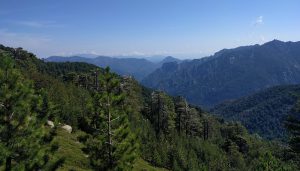Mediterranean regions bring to mind maquis shrublands and what is referred to as garrigue vegetation, which cannot be reproduced in our northern loamy regions, although certain evergreen Holm oaks or Kermes oaks may last for a while. At higher altitudes in the Mediterranean, forests of Black pine are found that are of much interest to our foresters. Black pine grows faster and straighter here than our own Scots pine; it has also been observed that Black pine thrives on sandy, dry soil. The exact taxonomic classification of Pinus nigra varieties is still under discussion, but a distinction has often been made between these subspecies: the ‘salzmanni’ from the Cévennes range and the Pyrenees, the ‘laricio’ from Corsica, the ‘calabrica’ from Southern Italy, the ‘nigra’ from Austria, the ‘dalmatica’ from Istria and the ‘palassiana’ from Greece and Crimea. Arboretum Group 28 is divided into subgroups where we encounter varieties from the Cévennes range, Corsica, and Calabria. All of the seeds from which the pines are grown come from these regions. To make these subspecies feel more at home here in Tervuren, they are often accompanied by southern European species that are common in their regions of origin, such as Maritime pine, Sweet chestnut, Downy Oak, ash, Italian Maple or Neapolitan Alder.


